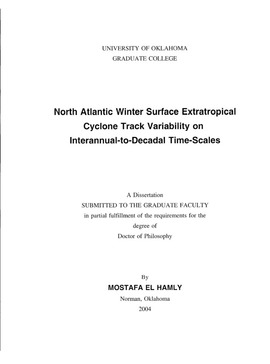| dc.contributor.advisor | Lamb, Peter J., | en_US |
| dc.contributor.author | El Hamly, Mostafa. | en_US |
| dc.date.accessioned | 2013-08-16T12:19:25Z | |
| dc.date.available | 2013-08-16T12:19:25Z | |
| dc.date.issued | 2004 | en_US |
| dc.identifier.uri | https://hdl.handle.net/11244/734 | |
| dc.description.abstract | The variability of cyclone activity at interannual and decadal-to-multidecadal time-scales is examined. First, interannual cyclone variability is classified into three major modes based on a VARIMAX Rotated Principal Component Analysis (VRPC) of CDF anomalies. Differences between the new CDF modes are emphasized in several respects (e.g., time-frequency decomposition of VRPC scores). Relationships of these unique modes to various atmospheric/oceanic circulation anomalies (in addition to NAO and ENSO) are then documented; the different physical mechanisms involved are elucidated. Further, decadal ocean-atmosphere interactions are explored via a new lead/lag CCA-based procedure. CDF also is used to re-examine the predictability of Moroccan precipitation anomalies by accounting for VRPC scores (besides NAO). Finally, new ensemble simulation of trends in LF NAO for 21st century climate changes using coupled ocean-atmosphere GCMs is analyzed. | en_US |
| dc.description.abstract | The CDF and related cyclone attributes are used to compile a new climatology (including persistence) of cyclone activity. This climatology will be arguably the most accurate and representative set yet compiled. Moreover, use of a novel aspect of wavelet analysis of CDF permitted (1) separation of the high-frequency and low-frequency (LF) components of cyclone activity; and (2) full 2-D grid analyses that document spatial heterogeneity of cyclone behavior, rather than areal averaging. | en_US |
| dc.description.abstract | Most recent automated methods for detecting and tracking cyclones suffer mainly from spatio-temporal inhomogeneities. To overcome these weaknesses, a new approach was developed to construct a hybrid space- and time-smoothed surface Cyclone track Density Function (CDF) over the North Atlantic Basin on a 2° x 2° grid with 1-day time resolution (Oct--Mar, 1948/49--1998/99). The CDF field is designed to provide a better description of storm tracks rather than tracking individual storms. Development of other related fields of cyclone characteristics (e.g., intensity, moving speed, duration) is enlightening because of additional physical insight/consistency provided. Thus, the aim of this analysis is to give new insight into the North Atlantic winter cyclone track organization and behavior. State-of-the-art techniques, models, and data sets were used to achieve this goal. | en_US |
| dc.format.extent | xi, 294 leaves : | en_US |
| dc.subject | Physical Oceanography. | en_US |
| dc.subject | Physics, Atmospheric Science. | en_US |
| dc.subject | Statistics. | en_US |
| dc.subject | Cyclone tracks. | en_US |
| dc.subject | Climatic changes. | en_US |
| dc.subject | North Atlantic oscillation. | en_US |
| dc.title | North Atlantic winter surface extratropical cyclone track variability on interannual-to-decadal time-scales. | en_US |
| dc.type | Thesis | en_US |
| dc.thesis.degree | Ph.D. | en_US |
| dc.thesis.degreeDiscipline | School of Meteorology | en_US |
| dc.note | Adviser: Peter J. Lamb. | en_US |
| dc.note | Source: Dissertation Abstracts International, Volume: 65-04, Section: B, page: 1912. | en_US |
| ou.identifier | (UMI)AAI3127800 | en_US |
| ou.group | College of Atmospheric & Geographic Sciences::School of Meteorology | |
